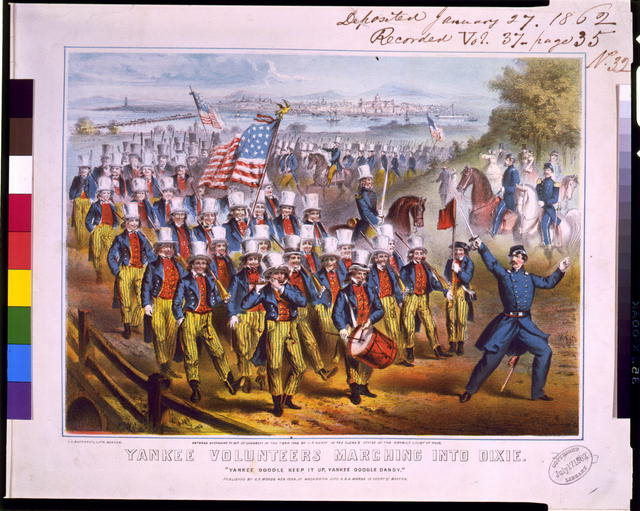Introduction
Political cartoons are generally regarded as a hypertrophied imagination of the political or social reality of the particular time epoch. The image that is selected for the analysis is from the pre-1856 epoch of US history, and it represents the imagination of the political and social life as it was imagined by artists. The cartoon that was selected for the analysis is Yankee volunteers marching into Dixie. This is regarded as a music cover 1862 year dated. This is a patriotic, and a bit sarcastic depiction of the Union forces.

Analysis
The general description of the picture presupposes that the Union forces are marching for opening the Civil War. The troop marches forward, and their dressings are characterized as the Yankee character Brother Jonathan (Brody, 106). The background of the poster depicts the skyline with capitol building. The interpretation of this painting is associated with the events before the civil war and is based on the fact that the Union forces were regarded as the only hope of the democratic development of the further American society.
Because political cartoons were based on the subjective perception of reality, it should be emphasized that the actual importance of the interpretation is associated with the necessity to explain the origins of the artist’s wish to attract attention to the fact of the civil war beginning. By the research by Lent (156), the following statement should be emphasized:
Political prints and satires have, quite appropriately, long been collecting interest for the congressional library. A particularly large group of such works from the late eighteenth century relates to the Revolutionary War period, including historical prints, satires, and allegories by American artists such as Paul Revere and Amos Doolittle, as well as British publishers from across the political spectrum.
In the light of this statement, the historical context of the analyzed poster is mainly associated with the necessity to analyze the sequence of the historic events, as well as the social background and moods of the people and soldiers. Because the poster depicts the very beginning of the Civil War, both sides of the conflict are highly inspired.
The interpretation accuracy may be doubted because the actual importance of the picture was to inspire the audience, and soldiers marching in white top hats look a bit strange. On the other hand, the colors of the US flag were regarded as a patriotic inspiration for everyone who should watch this poster. Therefore, the artist chose to draw the troops in national colors.
From the theoretic perspective of political satire and cartoons, it should be stated that the picture itself was aimed at increasing the level of self-consciousness and patriotism. In the light of this fact, the statement by Winfield and Yoon (234) emphasizes the importance of the political background and the necessity in such cartoons:
As the controversy grew in the United States over the proper form to be given the new government, cartoons and satires became an increasingly vital and ubiquitous component of the national public discourse in the formative years of the young republic. Two of the finest graphic satirists from this period, James Akin and William Charles, are well represented at the Library. For example, a rare impression of Akin’s virulent attack on President Thomas Jefferson for conducting secret negotiations with Spain toward the purchase of West Florida is significant not only as an early presidential satire but also as the earliest-known signed satire by Akin.
Hence, the United States army had to be depicted as a heroic and powerful force. Even though the national forces could not look like this, the authors managed to create the cartoon with a high level of inspiration, and create the necessary mood for motivating people.
The only reason why authors preferred to choose this type of interpretation may be explained by the fact that social advertisement was not developed highly. The national colors were regarded as the only inspirational hook possible for a political cartoon. These colors could be used either as for inspiration or for political sarcasm, however, while the warriors of the Union troops are depicted as dignified people, there is no space for sarcasm
The impact that it might have on the people is linked either with the pride for the dignity of the national troops, or with the irritation and anger of those who were on the opposite side of the barricades. Anyway, the authors reached their goal.
Conclusion
The cartoon analyzed may be regarded from several points, however, the main idea of the image is linked with the inspiration of the target audience. Hence, the interpretation of the cartoon from the perspective of inspiration and motivation may be regarded as the most accurate.
Works Cited
Brody, David and Henretta, James. America: A Concise History: Vol. 1, To 1877. 4th edition. New York. 2010.
Lent, John. Animation, Caricature, and Gag and Political Cartoons in the United States. Westport, CT: Greenwood Press, 2004.
Winfield, Betty H., and Doyle Yoon. “Historical Images at a Glance: American Editorial Cartoons.” Newspaper Research Journal 23.4 (2002): 97.